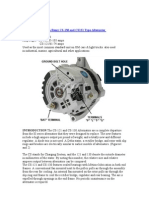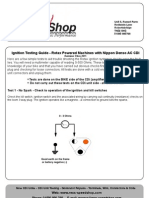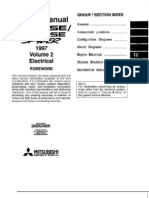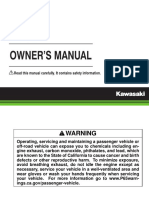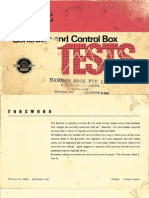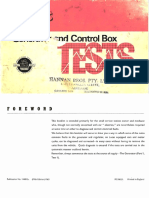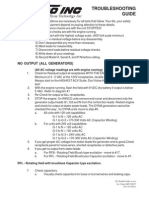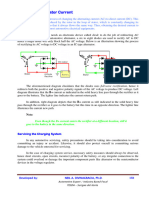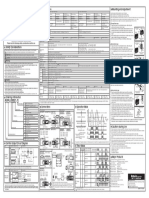Lucas Generator and Control Box Tests
Lucas Generator and Control Box Tests
Uploaded by
ruben_baleaCopyright:
Available Formats
Lucas Generator and Control Box Tests
Lucas Generator and Control Box Tests
Uploaded by
ruben_baleaCopyright
Available Formats
Share this document
Did you find this document useful?
Is this content inappropriate?
Copyright:
Available Formats
Lucas Generator and Control Box Tests
Lucas Generator and Control Box Tests
Uploaded by
ruben_baleaCopyright:
Available Formats
Generator and Control Box
F O R E W O R D
This bookl et is intended pri mari l y f or t he small service station owner and mechanic
who, though not normal l y concerned wi t h car " electrics," are nevertheless requi red
at some t i me o r ot her t o diagnose and correct electrical faults.
We believe t hat thi s bookl et wi l l serve t o show you a way i n whi ch some of t he mor e
common faults i n t he generator and regulator, on Lucas equipped cars and mot or
cycles, can be diagnosed and corrected-in many cases wi t hout having t o remove t he
units f r om t he vehicle. Quick diagnosis is ensured i f t he tests are carried out i n t he
systematic manner outl i ned herein.
Remember, always commence t he tests at t he source of supply-The Generator (Part 1,
Test 1).
Publication No. 1448 Ex. (Fifth Edition) 1963 ' ~F/1063/L Printed i n England
1 N D E X OF SYSTEMATI C FAULT LOCATI ON PROCEDURE
PART 1
Generator Tests f or Models:
C39PV C42
C39Q C45PV-5
C40A C45PV-6
C40/1 C45PVS-6
C4OAL C47
C40L C48
C4OLQ
Pages 3 - 4
Regulator Tests:
Compensated Voltage Con-
t rol .
Lucas Models: MCRI , MCR2,
RF95, RF95/3, RF96, RF97,
RBI 0611, RB106/2, RBI 07
and RBI08
PART 2
Pages 5 - 9
PART 3
Regulator Tests:
Cur r ent Voltage Control .
Lucas Model: RB310
3 Bobbin Type
wi t h screw t ype electrical
adjustment
Pages 10 - 16
OPri nted i n England
No part of this book may be reproduced without permission.
PART 4
Regulator Tests:
Cur r ent Voltage Cont rol .
Lucas Model : RB340
3 Bobbin Type
wi t h cam t ype electrical
adjustment
Pages 17 - 26
J O S E P H L U C A S ( E X P O R T ) L T D . . 4 6 P A R K S T R E E T . L O N D O N W. 1.
The following tests should be carried out wi th a good quality Moving Coil Voltmeter. The meter should have a full scale
deflection of at least 20 volts, wi t h divisions suitable for taking readings t o wi thi n 0.5 of a volt. A meter of this standard wi l l
be suitable for both 6 and 12-volt LUCAS equipped cars, trucks, etc., and 6 vol t systems on motor cycles.
ALWAYS CHECK BATTERY CONDI TI ON BEFORE COMMENCI NG TESTS
PART 1
GENERATOR TESTS WI TH THE MACHINE IN POSITION ON THE VEHICLE
TEST 1.
Disconnect leads from generator.
Connect one lead of voltmeter t o D
terminal and the other t o a good
ground.
Start engine and raise speed unti l
generator is running at approx.
3,000 revlmin.
When vehicle has a positive ground
system positive meter lead must be
grounded.
Inspect generator mounting for tightness of bolts, etc.
lnspect the fan belt for correct tension, adjust i f necessary. If worn or frayed fi t a new belt. Make sure drive
pulleys are correctly aligned.
If the belt and generator mounting are satisfactory and pulleys correctly aligned then proceed t o Test 1.
VOLTMETER CONNECTION I READING
B. Zero volts.
\
ACTION
A. 2-4 volts as generator is run up t o
charging speed (approx. 3,000 rev/
min) (6 and 12 vol t systems).
Examine brushes and make sure they
are free i n thei r boxes making good
contact on the commutator. If still
no reading fault is i n armature,
which has t o be replaced.
Armature and brush connections O.K.
proceed t o Test 2.
C. Rising volts wi t h rising speed. Internal short between D and F ter-
minals, examine field coils and rectify
as necessary or fit replacement.
VOLTMETER CONNECTION
TEST 2.
Connect met er as i n Test 1.
Li nk terminals D and F on generator.
Gradually speed up engine t o fast
"ti ck-over" speed. I f an ammeter
is used t o l i nk D and F, reading
should not be more than* 2 amps,
when normal voltage of system i s
registered on vol tmeter.
"2.5 for C42 wi t h 43 ohm field.
TEST 3.
Reconnect leads of generator.
Remove leads f r om D and F terminals
at t he cont rol box.
Connect one side of vol tmeter t o end
of D lead, t he ot her t o a good
ground, speed generator up t o
approx. 3,000 rev/min.
TEST 4.
Leave vol t met er connected as i n Test 3.
Joi n D and F wi res together.
Gradually speed up engine t o fast
"tick-over" speed.
READING
A. Rising vol ts wi t h rising speed-full
scale reading at fast tick-over.
B. 2-4 volts as engine i s revved up (6
and 12 vol t systems).
C. Zer o volts.
A. 2-4 vol ts (6 and 12 vol t systems).
B. Zer o volts.
C. Rising vol ts wi t h ri si ng speed.
A. Rising vol ts wi t h rising speed.
B. Zer o volts.
C. 2-4 vol ts (6 and 12 vol t systems).
ACTION
Generator i n order, proceed t o Test 3.
Open ci rcui t i n field coils, recti fy as
necessary o r fit replacement.
Grounded field coils o r field connection,
rectify as necessary o r fit replace-
ment.
D lead f r om generator t o cont rol box
is i n order. Proceed t o Test 4.
Rewi re D lead whi ch is open-circuited,
o r earthed.
Locate short between D and F cables.
Cables f r om generator t o cont rol box
are i n order. Proceed t o Test 5 i n
part 2, 3, o r 4 whichever is applicable.
Earthed F lead.
Open ci rcui t i n fi el d lead between
generator and cont rol bok.
BART 2
MODEL LRT9 REGULATOR - SI NGLE CONTACT 2 BOBBI N TYPE
(Used with RF95, 96, RB106/1, MCRZ, etc.)
COMPENSATED VOLTAGE CONTROL TESTS WITH UNIT I N POSITION
On no account must these tests be made wi t h the battery i n circuit.
To isolate the battery from the generator put a piece of dry card between the cut-out points. Remember the output
of the generator, that is the current i n amps. flowing from the generator t o the battery i s dependent on the state of charge of
the battery. The generator wi l l give a high output when the battery is i n a l ow state of charge and a l ow output when the
battery i s fully charged. Regulators must therefore always be set on open-circuit, a condition which is most easily obtained by
inserting the piece of dry card as described above, alternatively, wi thdraw cables from ' A' and A1 terminals and join together
temporarily.
VOLTMETER CONNECTION
TEST 5.
Reconnect generator leads t o control
box terminals D and F.
Connect one lead of voltmeter t o ter-
minal A, the other t o terminal E on
the control box. Engine stationary.
A. Battery voltage.
READING
Regulator ground connection i n good
order. Proceed t o Test 6.
ACTION
I
B. Less than battery voltage, or zero
reading.
Rectify bad ground or broken ground
wi re between terminal E and chassis.
VOLTMETER CONNECTION
TEST 6.
Proceed t o check regulator setting.
Remove cont rol box cover.
Isolate t he battery by placing a piece of
dr y card between cut-out contacts,
alternatively, remove ' A' and A1
cables f r om terminals and join
together temporarily.
Connect one lead of vol tmeter t o t er -
minal D (or frame of regulator) and
t he ot her lead t o a good ground.
--
READING
A. Wi t h generator runni ng at approx.
3,000 rev/ mi n voltage should remain
constant wi t hi n t he fol l owi ng l i mi ts :
Ambient Temp. 6 volt Equip. 12 vol t Equip.
O" ' ' OF) 8.0-8-5 16.0-1 6.5
20C 68F
B. Voltage remains constant, but out -
side t he given limits.
C. Rising vol ts wi t h rising engine speed
up t o 3,000 r evl mi n and beyond.
ACTION
Regulator i n order.
Proceed t o Test 7.
- - -
Adjust regul ator by t ur ni ng t he adjust-
i ng screw clockwise t o increase o r
counter-clockwise t o l ower t he set-
ting. Check setti ng by raising speed
f rom zero.
Check ' D ' and ' F ' leads f or short-
circuit, i f O.K. suspect broken shunt
wi ndi ng i n regul ator bobbin. The
ground lead f r om cont rol box t er -
minal E is common t o bot h shunt
windings (regulator and cut-out).
Hol d a screwdri ver near t op of t he
bobbins and test f or magnetic pull.
If t here is pul l on t he one bobbi n
core and not on t he ot her suspect
open ci rcui t on t he latter. If no pul l on
ei ther checkf oropen ci rcui ted ground
lead. Replace defective regulator.
-.
VOLTMETER CONNECTION READING
TEST 6 (continued). D. Reading approx. half setting.
ACTION
Suspect regulator contacts not passing
i
current causing t he contacts resistor
I
t o be i n ci rcui t t he whol e time. To
test, bridge t he contacts wi t h screw-
ARMATURE
FIXING SCREWS /
dri ver. This closes t he ci rcui t between
REGULATOR
i
D and F and we should get rising volts
FRAME I wi t h rising speed, thus provi ng t he
1
contacts are bur nt o r corroded.
--
E. Voltage does not rise wi t h
engine speed, o r is erratic.
FIXED CONTACT 0. 006' ~0. 017"
BRACKET WI TH ARMATURE
PRESSED TO CORE
Diagram 1.
Check air-gap Settings Types MCRI ,
MCR2, RF95, 96, 97, RB106/1. Insert
a 0.020'' feeler gauge between t he
crank of t he armature and t he L-
shaped frame, and 0.012-0.020" gauge
between t he t op of t he core and t he
underside of t he brass shim on t he
armature. Loosen t he screws hol di ng
t he regulator armature to t he t op of
t he L-shaped frame. Press downwards
and backwards. Ti ghten t he screws
and check t hat clearances are as
shown i n diagram 1.
VOLTMETER CONNECTION 1 READING
ARMATURE ASSEMBLY FIXED COPUTACT
SECURING SCRiWSz& I-' ADJUSTMEl\T
' IDfi.
m! -: . i SCRE'N
CORE
ALTERNATIVE COPPER
SEPARATION ON
BOBBI N CORE
DISC TWO WIPE, %ur n
TYPE OF SEPAPATION
S x
ARMATURE
/
DISC OR TWO WI W- - -0.015'
A ND
WPPFR
SEPAR4TION
Diagram 2.
ACTION
Types RF95/3, RB106/2, RBI07 and
RBI 08.
Slacken the fixed contact screw and
unlock armatgre securing screws.
Insert appropriate feeler gauge be-
tween armature and core face. Press
armature down squarely against the
gauge and re-tighten securing screws.
Wi t h gauge in position, screw the
fixed contact down unti l i t just
touches the moving contact and
tighten lock nut, see diagram 2.
Reset the voltage adjusting screw as
described under 6B.
TEST 7.
Remove card from between cut-out
contacts.
Connect voltmeter t o terminal A on
control box and a good ground.
Engine stationary.
TEST 8.
Leaving voltmeter connected as for
Test 7. Start engine and watch
voltmeter.
Proving that circuit from battery
through ammeter t o A terminal i s
O.K. Proceed t o Test 8.
Battery voltage.
A. As cut-out closes the reading should
increase 0.5 t o 1 vol t above battery
voltage, and increase t o the regulator
setting i n Test 6.
B. No voltage or very l ow voltage is
recorded when cut-out ~ o i n t s close.
Cut-out i s i n order. Proceed t o Test 9.
Clean and adjust cut-out contacts so
that they meet correctlv.
VOLTMETER CONNECTION 1 READING
I
ACTION
TEST 9.
Connect one lead of voltmeter t o D
terminal of regulator or t o the regu-
lator frame itself.
Other voltmeter lead t o agood ground.
C. Cut-out does not close.
6. Cut-out points close outside above
limits.
Fit replacement unit.
A. Cut-out points close when voltage
is wi thi n the following limits :
6 vol t 12 vol t
6.3-6-7 12.7-1 3.3
Adjust by turni ng adjusting screw i n
t o increase or out t o decrease the
setting. Re-test wi t h voltage rising
from zero.
THE FUNCTI ON OF THE FUSES IN THE AUXlLlARY CIRCUITS
IN 12 VOLT SYSTEMS
Cut-out is i n good order.
Two fuses are incorporated i n RF95 control boxes. The main feed i s via the ammeter t o the A terminal of the control
box, then through the series winding i n the box t o A1 terminal. Terminal A1 is also the feed t o the ignition switch and from
there t o A3 via internal connections i n the control box through the fuse t o A4 terminal. Any accessories connected t o A2 wi l l
wor k irrespective of the ignition switch position. Accessories connected t o A4 wi l l operate only when the ignition i s switched
on,
The system i s similar on RF96, 86106 and RE310612 control boxes, but the fuses are mounted on a separate bake
PART 3
MODEL RB310 REGULATOR- SINGLE CONTACT 3 BOBBI N TYPE
CURRENT VOLTAGE CONTROL REGULATOR TESTS WITH UNIT IN POSilPlON
Instruments requi red : Movi ng coil Ammet er 0-40 amperes.
Movi ng coil Vol tmeter 0-20 volts.
The Cur r ent Regulator is adjusted, before leaving t he factory, t o suit t he rated out put of t he generator whi ch it is t o
control . I t is i mport ant therefore, t hat t he Model of t he generator is carefully noted before commencing t he tests. This is
stamped on t he yoke of t he generator.
f ernperature Correct i on Factor
Correcti ons t o be made t o t he open-circuit voltage l i mi t s when checking o r adjusting settings at temperatures ot her
than 20C (68F) are as follows:-
For every 10C (1 8F) above 20C,, subtract
0.1 vol t f r om t he 6-vol t l i mi ts
0.2 vol t f r om t he 12-vol t l i mi t s
Conversely, t he same correcti ons must be added f or every 10C below 20C.
For generator tests, repeat Tests 1 - 4, of Part 1, t hen proceed t o Test 5, on page 11.
page 10
!
AMMETER CONNECTION i READING ACTION
I
TEST 5 : Cur r ent Regulator. i A. Wi t h generator at ful l charging Cur r ent regulator i s i n order. Proceed
; speed, approx." 4,500 revl mi n, t he t o Test 6.
Reconnect ' D' and F leads t o generator current reading is wi t hi n t he fol l ow-
terminals. ing l i mi ts: *4,000 revl rni n f or C48.
For generator Models:
Remove cont rol box cover. C40/1 12V:20amps.f1 amp.
( wi t h 6" fan).
Short ci rcui t voltage regulator contacts 1 C40/1 12V:22 amps.fl amp.
wi t h a crocodile cl i p connected ( wi t h 5" fan).
across contact plate and frame of ~ C42
regulator. I (Easidrive) 12V:35 amps.& 4 amp.
C40AL 12V: l l amps.&l amp.
Disconnecr. lead f r cm termi nal B (Bat- ~ C40 L 12V:25 amps. f 14 amps.
t ery) and connect this lead t o nega- : C40LQ 12V:25 amps.&lQ amps.
t i ve ammeter lead.
1
C42 12V:30 amps.& + amp.
C45PV-5 6V:33 amps.&l+ amps.
Connect positive ammeter lead t o
termi nal B.
To load t he generator switch on head-
C45PV-5 12V:22 amps.* l amp.
C45PV-6 12V:25 amps.51 amp.
C45PVS-6
12V:25 amps.&l amp. ~
C39Q 32V:19 arnps.&l amp.
lights, etc. and start engine.
I
C39PV-2 12V:19 amps.&l amp. 1
C47 12V: 30amps . ~l ~amps . I
C48 12V:35 amps.&I+ amps.
I
(Do not swi tch lights on after start- i
ing engine otherwi se t he bulbs may
I- -- -
!
burn out.) Adj ust regui ator by t ur ni ng t he adjust-
1-
ing screw clockwise t o increase o r
1 5. Cur r ent remains constant but not anti-clockwise t o reduce t he charging
I wi t hi n limits. rate.
page 11
AMMETER CONNECTION
TEST 5 (continued).
CURRENT REGULATOR
ARMATbRE ASSEMBLY FIXED CONTAC?
SECURiPIG SCREWS ADJUSTMENT
TENSI ON _
SPRI NG
CURRENT A~JUSTMENT SCREW
AND LOCKI NG NUT
ALTERNATI VE COPPER
SEPARATI ON O N
DI SC SQUARE
ARMATURE
T - F
SEPARATI ON
GI\UGE
Dl SC
SQUARE
Diagram 3.
READING
C. Cur r ent errat i c o r cannot be ad-
justed wi t hi n limits.
page I 2
ACTION
Check air-gap setti ng (see diagram 3),
unlock and screw back fi xed contact
and current adjustment screws. Slack-
en of f armature assembly securing
screws. Insert appropri ate gauge be-
tween armature and copper disc on
t op of coil. Press armature down
squarely against gauge and re-ti ghten
securing screws.
Re-adjust current as i n B and if st i l l not
wi t hi n limits, fit a replacement unit.
VOLTMETER CONNECTION
TEST 6 : Voltage Regulator.
Remove test ammeter and leave the B
(Battery) lead disconnected. Also
remove clip across contact plate.
Connect voltmeter between D ter-
minal and ground.
VOLTAGE REGULATOR ~ ~
ARMATURE
ASSEMBLY
(REAR VIEW) ALTERNATIVE COPPER
SEPARATION ON
BOBBI N CORE
DISC SQUARE
I') i.1
0 I - METAL
BRIGHT UNPLATED A )
OR COPPER PLATED ( 6 )
ARMATURE
Diagram 4.
READING
A. Voltage rises steadily wi t h generator
running at about* 3,000 rev/min.
Voltage should remain steady wi thi n
the following limits:
Ambient Temp. 6 volt C/Box I 2 volt C/Box
Wi t h increased speed, voltage does
not increase more than 1-13 volts.
"1,500 rev/min for C47 and C48.
B. Voltage remains constant but out-
side the given limits.
C. Voltage does not rise wi t h engine
speed or i s erratic.
ACTION
Regulator i n order.
Proceed t o Test 7.
Adjust regulator by turni ng the adjust-
ing screw clockwise t o increase and
anti-clockwise t o decrease t he setting.
Check air-gap and adjust i n similar
manner t o Test 5 (C) (see diagram 4).
Re-adjust voltage as i n B above and i f
still not wi thi n limits, fit replacement
unit.
page I 3
VOLTMETER CONNECTION
--
TEST 6 (conti nued).
BOBBI N
\
CORE
FIXED CONTACT
ADJUSTMENT
URE ASSEMBLY
- TENSI ON SPRI NG
VOLTAGE ADJUSTMENT SCREW
AND LOCKING NUT
TEST 7.
Re-connect 5 lead t o regulator. Con-
nect vol t met er t o B termi nal and t o
a good ground. Engine stationary.
READING
D. Rising volts wi t h rising engine,
speed up t o 3,000 rev/ mi n and
beyond.
Battery Voltage.
page 14
ACTION
-
Check ' D ' and F ' leads f or short-
circuit, i f O.K. suspect broken shunt
wi ndi ng i n regulator bobbin. Shunt
windings on both voltage regulator
and cut-out bobbins are t o common
earth. Hol d a screwdri ver near t op
of voltage and cut-out bobbins and
test f or magnetic pull.
If no pull check f or open ci rcui ted
ground !ead o r shunt winding.
I f defective fit replacement regulator.
Ci rcui t f r om battery t o regul ator i n
order.
Proceed t o Test 8.
VOLTMETER CONNECTION
TEST 8.
Leaving vol t met er connected as f or
Test 7, start engine and slowly
increase speed and watch voltmeter.
TEST 9.
Connect one lead of vol tmeter t o D
termi nal of regulator and ot her vol t-
met er lead t o a good ground.
READING
--
A. As cut-out closes, reading increases
t o 0.5 t o 1.0 vol ts above battery
voltage and increases as speed i s
increased t o t he regulator setting
voltage i n Test 6.
B. N o voltage o r very l ow voltage is
recorded when cut -out points close.
A. Cut -out poi nts close when voltage is
wi t hi n t he f ol l owi ng l i mi ts :
6 vol t
6.3-6.7
12 vol t
12-7-1 3-3
B. Cut -out poi nts close outside above
limits.
C. Cut -out does not close.
ACTION
Cut-out is i n order.
Proceed t o Test 9.
Clean and adjust cut-out contacts so
t hat t hey meet correctly. Wi t h
0.010" gauge between armature and
bobbin core face contacts should be
just touching.
Cut -out i n good or der and correct l y set
Proceed t o FI NAL CHECK.
Adj ust by t ur ni ng adjustment screw i n
t o increase o r out t o decrease setting.
Fit replacement unit.
page 15
AMMETER CONNECTION READING
TEST 10. FINAL CHECK.
Leave voltmeter connected as for
Test 9.
Insert ammeter again between terminal
B and A cable as i n Test 5.
Steadily increase engine speed and
watch both meters.
Switch on full lighting load.
As speed increases cut-out closes between
12.7-13.3 volts and charging rate builds
up wi t h increasing speed.
Ammeter reading equals maximum rated
output of the generator.
METRIC EQUIVALENTS
&" dia. =2-38 mm.
0.005" = 0.1 27 m m.
0.006" = 0-1 52 rnrn.
0.01 0" = 0.25 m m.
0-01 5" = 0.396 mm.
0.020" = 0-51 m rn.
0.025" = 0.635 mm.
&" dia. = 1-98 mm.
ACTION
0.030" = 0.76 m rn.
0.032" = 0.81 mm.
0.045" = 1 -04 m m.
0.049" = 1 -24 m m.
0.1 50" = 3-8 m m.
page 16
PART 4
MODEL RB340 REGULATOR- SI NGLE CONT ACT 3 BOBBI N
TYPE
CURRENT VOLTAGE CONTROL REGULATOR TESTS WBTH UNIT IN POSITION
Instruments requi red : Movi ng Coi l Ammet er 0 - 40 amperes
Movi ng Coi l Vol t met er 0 - 20 volts
Special Tool Part No. 543 817 42
Except f or adjustment of t he cut-out relay drop-off voltage, whi ch is effected by bending t he fi xed contact bracket,
electrical settings are made by t ur ni ng t oot hed adiustment cams carried on t he f r ont l i mb of each magnet frame. A special
t ool is available f or this purpose. Back ai r gaps are fi xed and non-adjustable and t he onl y mechanical settings t hat may be
requi red comprise simple adjustments t o t he armature-to-bobbin core air gaps.
The Cur r ent regulator i s adjusted, before leaving t he factory, t o sui t t he rated out put of t he generator whi ch it is t o
control . The nominal setting is rubber-stamped ei t her on t he underside of t he '8-8' termi nal plate o r on t he cover. In addi ti on
a l i st of Lucas generators together wi t h t hei r rated out put is given i n t he appropriate section of thi s bookl et. The model
o f t he generator, which is stamped on t he yoke of t he machine can be noted before commencing t he tests.
Temperature Correction Factor
Correcti ons t o be made t o t he open-circuit voltage l i mi ts when checking o r adjusting settings at temperatures ot her
than 20C (68F) are as follows:-
For every 10C (18F) above 20C subtract 0.2 vol t f r om t he 12-volt l i mi t s
Conversely, t he same corrections must be added f or every 10C below 20C
For generator tests, repeat Tests 1 - 4, of Part 1, t hen proceed t o Test 5, on page 18.
page 17
AMMETER CONNECTION
TEST 5 : Cur r ent Regulator.
Reconnect leads t o D and F on
generator.
Remove cont rol box cover.
Short out voltage regulator contacts
wi t h a bulldog clip.
Using a suitable ' j umper lead' connect
t he leads t o t he load side of 0 - 4 0
ammeter.
Connect ot her lead of ammeter t o one
of cont rol box termi nal blzdes B-B.
Note: It is i mport ant t o ensure that
termi nal B-B carries onl y this
one connection. Al l ot her
load connections (including t he
i gni ti on coil feed) must be
made t o t he battery side of t he
ammeter.
Switch on lights t o ensure generator
develops i t s rated output.
Start engine and r un generator at
4,500 rev/ mi n (4,000 rev/mi n f or
C48).
READING
A. Ammet er poi nt er should be steady
and indicate a current equal t o
maxi mum rated out put of generator:
C40/1 12V:20 amps.&l amp.
( wi t h 4h" dia. fan)
C40/1 12Y:22 amps.&l zmp.
( wi t h 5" dia. fan)
C45PV-5 12V: 22amps. f l amp.
C45PV-6 12V:25 amps. f I amp.
C45PVS-6 12V:25 amps.i-1 amp.
C39PV-2 12V:19 amps.& I amp.
C47 12V:30 amps.&l+ amps.
C48 12V:35 amps.&l+ amps.
C40AL 12V: l l a mp s . i l amp.
C40 L 12V:25 amps.*I amp.
C40LQ 12V:25 arnps.i-1 amp.
C42 22V:30 anips.&1+ amps.
C42
(Easidrive) 12V:35 amps.&l+ amps.
- --
B. Ammet er poi nt er remains steady
but current reading outside limits.
ACTION
Cur r ent regulator i s i n order, proceed
t o Test 6.
SHORT CIRCUITING~
V R CONTACTS.
Tur n t he current adjustment cam unt i l
correct setting is obtained - t ur ni ng
t he t ool clockwise t o raise t he setti ng
or anti-clockwise t o l ower it.
page 18
CURRENT REGULATOR
i
VOLTAGE REGULATOR
AMMETER CONNECTION
CLIP
READING ACTION
TEST 5 ( cont i nued) .
1 C. An unsteady reading, i.e. poi nt er i s
I
fluctuating mor e than & 1 amp.
Check f or di r t y contacts, o r foreign
matter i n ai r gaps.
I f i n order, check ai r gap setti ng
between armature and bobbi n core
as follows :-
Turn the adjustment cam t o the point giving
minimum lift t o the armature tensioning
spring, by turning the tool t o the fullest
extent anti-clockwise.
Slaclten the adjustable contact loclting nut and
screw back the adjustable contact.
Insert a flat steel feeler gauge of 0.045" (1.04
mm.) thicltness between the armature and
the copper separation on the core face. The
gauge should be inserted as far back as the
two rivet heads on the underside of the
armatu re.
Retaining the gauge in position and pressing
squarely down on the armature, screw in the
adjustable contact until it just touches the
armature contact.
Re-tighten the loclting nut and withdraw the
gauge.
Carry out the electrical setting procedure.
If still not within limits fit a replacement unit.
page 19
VOLTMETER CONNECTION 1 READING
TEST 6 : Voltage Regulator.
Remove test ammeter, and leave B-B
leads disconnected.
Not e: It wi l l be necessary t o join the
ignition and battery feeds to-
gether wi t h a suitable 'jumper
lead', t o enable the engine t o
be run.
Also remove bulldog clip from across
contacts.
Connect voltmeter between D ter-
minal and ground (earth).
Note: A convenient method is t o
wi thdraw the ignition warning
light feed from control box
t&minal WL and t o clip volt-
meter lead of appropriate pol-
ari ty t o the small terminal
blade then exposed, this ter-
minal being electrically com-
mon wi th terminal D.
Start the engine and run the generator
at 1,500 rev/min for C48, 4,500 rev/
min for C42,3,000 rev/min all others.
A. Voltmeter reading should be steady
and lie between the appropriate
limits :
Ambient Temp. Setting
10C (50F) 14.9 - 15.5 volts
20C (68F) 14-7 - 15.3 volts
30C (86F) 14.5 - 15.1 volts
40C (104F) 14.3 - 14.9 volts
ACTION
Voltage regulator i s i n order. Proceed
t o Test 7.
VR AND C.R
ARMATURE TO BOBBIN CORE GAP
0. 045" 0 - 0 4 9 "
,,I
'\
CONTACT ADJUSTMENT
page 20
VOLTMETER CONNECT1ON 1 READING
I
ACTION
TEST 6 ( cont i nued) B. Vol t age r eadi ng r emai ns const ant
b u t out si de appr opr i at e l i mi t s.
-
Adj ust r egul at or by r ot at i ng t h e adj ust -
ment cam. Tur n t he t ool cl ockwi se t o
raise t he set t i ng o r anti -cl ockwi se t o
l ower it.
~ - -
Check D and F leads f or shor t - ci r cui t , i f
O.K. suspect br oken shunt wi ndi ng i n
r egul at or bobbi n. Shunt wi ndi ngs on
bot h vol tage r egul at or and cut - out
bobbi ns ar e t o common earth. Hol d a
scr ewdr i ver near t o p of vol tage and
cut - out bobbi ns and t est f or magneti c
pul l .
I f no pul l check f or open ci r cui t ed gr ound
lead o r shunt wi ndi ng.
If defecti ve fit repl acement r egul at or .
Check f or di r t y contacts, o r f or ei gn
mat t er i n gaps.
I f i n or der check ai r gap bet ween ar mat ur e
and bobbi n cor e face, as f ol l ows:
Turn the adjustment cam t o the poi nt giving
minimum l i f t t o the armature tensioning
spring, by turni ng the t ool t o the fullest
extent anti-clockwise.
Slacken the adjustable contact locking nut and
screw back the adjustable contact.
insert a flat steel feeler gauge of 0.045" (1.04
mm.) thickness between the armature and
the copper separation on the core face. The
gauge should be inserted as far back as the
t wo ri vet heads on t he underside of the
armature. (continued)
C. Ri si ng vol t s wi th r i si ng engi ne, speed
u p to 3,000 r ev / mi n and beyond.
page 21
EXTERNAL CONNECTIONS SHOWN IN BROKEN LiNE
, - - - - - - - - - - - - - -. - - -. . . . . . - - -. .
,
I , z:::
-- --_I
; "E" VOLTAGE
RELAY REGULATOR
I . . I_.
...
t- - - - - -.: - - - - - - - - - - - - - - -
D 0 a . v L
N -
UNTi L EARL? i N 1962, THE VR. I CR MLGNLI F W E S WERE LINKED BY A CONNECTOR THROUGH WHICH
(IN THE CONTACTS CLOSE0 POSI TI @Y) THE FlELD CURRENT PAIIELI. VI A THE C.O. i CR SERI ES
WINDINGS, TO TERMINAI'D:
D. Vol t met er r eadi ng
f l uct uat es, i.e.,
poi nt er f l uct uat i ng
mo r e t han 0.3-vol t.
VOLTMETER CONNECTI ON
TEST 6 (continued)
TEST 7.
Wi t h engine stationary. Reconnect
leads t o B-B termi nal on cont rol box.
Connect vol t met er between B-B t er-
minal and ground.
TEST 8.
Leave vol tmeter connected as f or
Test 7.
Start engine, and slowly increase speed,
closely watching vol tmeter dial.
READI NG
D. (continued)
Battery voltage.
A. As cut-out closes, reading rises t o 0
t o 1.0 volts above battery voltag
and continues t o rise as engine spec
is steadily increased, unt i l regulatc
setting voltage, as given i n Test 6,
reached.
B. N o voltage o r very l ow voltage
registered when cut-out contac
close.
ACTI ON
Retaining t he gauge i n posi t i on and pressing
squarely down on t he armature, screw i n t he
adjustable contact unt i l it j ust touches t he
armat ure contact.
Reti ghten t he l ocki ng nut and wi t hdr aw t he
gauge.
Car r y out t he el ectri cal set t i ng procedure.
If st i l l not wi t hi n l i mi t s fit a repl acement uni t .
Circuit from battery t o regulator i s i n
order.
Proceed t o Test 8.
Cut-out is i n order. Proceed t o Test 9.
Check for di rty or burned contacts.
Check for contact alignment.
Check that they meet correctly when
armature is pressed down, the moving
contact blade should have a deflection
of 0.01 0" - 0.020".
Armature back stop t o core air gap
should be between 0.035'' - 0.045.
page 22
VOLTMETER CONNECTION READING
TEST 9 : Cut-i n Voltage.
Connect vol t met er between D on
cont rol box and ground.
Switch on headlamps.
Start engine and slowly increase its
speed. Observe t he vol tmeter
pointer.
- -- - - ---
A. Voltage reading rises steadily and
then drops slightly at t he instant
t he contacts close. The cut-i n vol t -
age i s t hat whi ch is indicated i mmedi -
ately before t he poi nt er drops back.
I t should occur between t he fol l ow-
i ng limits:-
12.6 - 13.4 volts.
CUT- OUT
B. Cut -out contacts close outside limits.
C. Cut -out contacts wi l l not close.
ARMATURE TO BOBBIN CORE GAP
(0.035"- 0. 045")
page 23
ACTION
Cut -out i s i n or der . Proceed t o Final
Check, Test 10.
Adj ust cut-out by rot at i ng t he adjust-
ment cam, t ur n t he t ool clockwise t o
raise t he setting o r anti-clockwise t o
l ower it.
Again check cut-in voltage.
Repeat procedure unt i l correct setting
obtained.
Fi t a replacement unit.
VOLTMETER CONNECTION I READING
TEST 10 : Dr op off voltage.
Wi t hdr aw leads control box B-B
terminals.
Connect vol tmeter between B-B t er -
minals and ground.
Start engine and r un up t o 3,000 rev/
min.
Slowly decelerate and observe vol t-
meter poi nter.
ACTION
A. Openi ng of contacts. indicated by
t he vol t met er poi nt er droppi ng t o
zero, thi s should occur between t he
fol l owi ng l i mi t s :
9.3 - 11.2 volts
Cont r ol box i n or der
B. Drop-off occurs outside limits.
PHOSPHOR BRONZE
HINGE SPRING
\
ARMATURE
/ CONTROL
Adj ust Drop-off volts as follows :-
Stop engine, and adjust t he drop-off
voltage by carefully bending t he fi xed
contact bracket. Reducing t he con-
tact gap wi l l raise t he drop-off
voltage; increasing t he gap wi l l l ower
t he drop-off voltage.
Re-test and, i f necessary, readjust unt i l
t he correct drop-off setting is
obtained.
Note: When drop-off voltage is correct
t he moving contact blade should
have a ' fol l ow t hrough' o r blade
deflection o f 0.010" - 0.020".
The armature back stop, when free,
should give a core gap of 0.035"
- 0.045", adjust by bending stop wi t h
a suitable tool .
BLADE \ \
FOLLOW-THROUGH' 'B%'TERMINAL FIXED CONTACT
0.010'-0.020") PLATE BRACKET
page 24
RB340 DESIGN DATA (12-volt units)
RESISTOR VALUES
(i) Contacts Resistor : Resistance Identification (ii) Swamp Resistor : Resistance in RESISTANCE OF SHUNT
in Ohms Colour (12-volt Units) Ohms WINDINGS a t 20C (68F)
As fi tted t o units con- Measured on unit bet- Voltage
trollingl2-voltgenerators ween centre tag and Regulator: 10-8-12-0 ohms
havi ng 44 ohm f i el d base : 13.25 - 14.25 Cut-out : 8.8 - 9.6 ohms
windings : 37- 43 Yellow
Replacement resistor
As fi tted t o units con- measured between end
trol l i ngl 2-vol t generators tags before fi tti ng t o
hav i ng 6 o h m f i e l d unit : 53 - 57 ADJUSTMENT CAMS
windings : 55 - 65 Red Torque to
(iii) Field Parallel Resist- t urn cams : 2 - 4 Ib. in.
ance : (0.023 - 0.046 kg m.)
SWAMP RESISTOR CONTACTS RESISTOR
FIELD PARALLLL
RESISTOR
(WHEN FITTED)
'8-13' TERM I NAL
PLATE
z B - 8' ,F' 'W L: 'D' 'E'
i
,
As fitted t o units con-
t r ol l i ng model C48
generator : 37 - 43
AIR GAPS
Length
Armature back gaps (non- 0-030" - 0.035"
adjustable) : (0.76 - 0.9 mm.)
Armature-to-bobbin core, 0.045" - 0.049"
VR and CR : (1.04 - 1 -24 m m .)
Armature-to-bobbin core, 0.035" - 0.045"
Cut-out relay : (0.9 - 1.04 mm.)
'Follow-through'or blade
deflection of cut-out reiay 0.01 0" - 0.O2Otc
moving contact : (0.25 -,0.51 mm.)
page 25
C O N T A C T REPLACEMENT SETS
Contact replacement sets are supplied solely for use overseas,
where special service problems are encountered. The fi tti ng of
these sets involves the replacement of existing rivets wi t h screws.
The Part Numbers of the sets are 543 820 77-8 and 9 for the
Cut-out Relay, Voltage and Current Regulators, respectively. Each
set comprises an Armature Assembly, Clamp,Plate, Fixed Contact
Screw and Nut (or, for cut-out relays, a B-B' Terminal Plate
Assembly), and t wo 5 BA screws wi t h associated spring washers
and lock nuts (two extra screws, spring washers and lock nuts being
provided for the cut-out relay t o secure the above terminal plate
assembly).
IDENTIFICATION OF ARMATURE ASSEMBLIES
(i) Cut-out relay Moving contact carried on phosphor bronze
armature : blade.
Phosphor bronze hinge spring unpierced.
Blued steel control spring backed wi t h
bi-metal spring (high expansion side l ower-
most).
(ii) Voltage regulator Bi-metal hinge spring pierced wi t h central
armature : 0.150 (3.8 mm.) hole. (High expansion
side of bi-metal uppermost).
(iii) Current regulator
armature : Blued steel hinge spring, unpierced.
FITTING ARMATURE ASSEMBLIES
(i)
Carefully remove existing rivets, using a file, centre-punch,
t wi st dri l l (&" diameter; 2.38 mm.), and a parallel-sided
punch (&" diameter; 1.98 mm.), i n that order.
(ii)
Discard original armature, clamp plate, and fixed contact
screw and nut, or, when replacing a cut-out relay armature,
the 'B-B' terminal plate.
(iii)
Loosely assemble replacement parts t o magnet frame, noting
that the armature hinge spring has open-ended slotted fixing
holes t o facilitate fi tti ng under the clamp plate.
Do not insert the fixed contact screw of the VR or CR more
than I+ t o 2 turns at this stage.
(iv) When applicable, fit and tighten replacement 'B-B' termi nal
plate, inserting the securing screws from the supper side of
the control box base plate.
(v) Insert a 0.032 (0.81 mm.) feeler gauge approximately half-way
up the back air gap.
(vi)
Insert a 0,045 (1.04 mm.) feeler gauge i n the armature-to-
bobbin core gap as far back as the t wo tension spring rivets.
(vii) Press the armature squarely down towards the bobbin core
and back towards the magnet frame, fi rml y trapping both
gauges.
(viii) Tighten the armature assembly securing screws.
(ix) Wi thdraw gauges and carry out mechanical and electrical
adjustments.
ADJUSTMENT SEQUENCE
After fi tti ng a replacement contact set (or sets), the regulator o r
cut-out relay concerned must be adjusted both mechanically and
electrically. The order of electrical settings (when all three arma-
tures have been replaced) being, first, the voltage regulator, secondly
the cut-out relay and, thi rdl y, the current regulator.
page 26
You might also like
- Werkstatthandbuch Linhai 310 420 600Document514 pagesWerkstatthandbuch Linhai 310 420 600Felix Leone Enache100% (2)
- Yamaha Dragstar Xvs250 Uputstvo ManualDocument82 pagesYamaha Dragstar Xvs250 Uputstvo ManualVladimir ZaljevskiNo ratings yet
- How To Read Your FI LightDocument2 pagesHow To Read Your FI Lightsundarshun100% (1)
- Remote Meter MT 50 ManualDocument36 pagesRemote Meter MT 50 ManualNaiIanNo ratings yet
- FZ6 Vs Z750Document6 pagesFZ6 Vs Z750Andrea Manca100% (1)
- Sail NB Diesel MY15 28287957Document212 pagesSail NB Diesel MY15 28287957L Pampana100% (1)
- Service Manual Delco-Remy CS-130Document10 pagesService Manual Delco-Remy CS-130api-2614064460% (5)
- ML 155 PDFDocument2 pagesML 155 PDFBuwana luhur100% (1)
- Photo: ED TypeDocument27 pagesPhoto: ED Typespscribd1No ratings yet
- Husaberg 2000Document34 pagesHusaberg 2000ktm7ak100% (1)
- 2014 Ducati Hypermotard 5Document211 pages2014 Ducati Hypermotard 5zp zp100% (1)
- RE04R01ADocument217 pagesRE04R01As9h6zrywf4100% (1)
- FZ09 2016Document78 pagesFZ09 2016Motopowersports EmpresaNo ratings yet
- 02 Gv250 Spare Part CatalougeDocument62 pages02 Gv250 Spare Part CatalougejoyNo ratings yet
- 2007 Sportster Trouble CodesDocument14 pages2007 Sportster Trouble CodesmarcelopardhalNo ratings yet
- Rotax Ignition TestingDocument4 pagesRotax Ignition TestingmarcusrexNo ratings yet
- FZ-09 Owners Manual 2014Document110 pagesFZ-09 Owners Manual 2014Varios VideosNo ratings yet
- Honda S2000 Clutch BuzzDocument1 pageHonda S2000 Clutch BuzzWilliam KatzNo ratings yet
- At115c 2006 (Nouvo) 5mx-F8197-E1 (Supplementary)Document61 pagesAt115c 2006 (Nouvo) 5mx-F8197-E1 (Supplementary)loretohNo ratings yet
- Réglages Suspension OhlinsDocument5 pagesRéglages Suspension OhlinsazuertohbshhhNo ratings yet
- Triumph Tr7 Tr8 Fuel Injection HandbookDocument82 pagesTriumph Tr7 Tr8 Fuel Injection Handbookjorge Angel LopeNo ratings yet
- 2005 Service LIT 11616 18 43Document36 pages2005 Service LIT 11616 18 43Dawie HenningNo ratings yet
- XZ400 (14X) Owners ManualDocument18 pagesXZ400 (14X) Owners ManualRohan SimonNo ratings yet
- 1999 SR125 Suppl Serv ManualDocument25 pages1999 SR125 Suppl Serv ManualBobby HawkNo ratings yet
- B517 Figo Final Output 8thnov2012Document78 pagesB517 Figo Final Output 8thnov2012Dheep UNo ratings yet
- Eclipse 90-99 ElectricalDocument540 pagesEclipse 90-99 ElectricalManuel VizaNo ratings yet
- 420a TimingDocument4 pages420a TimingBobby PaisonNo ratings yet
- Ohlins DTC Einbauanleitung FPK 107 EnglischDocument6 pagesOhlins DTC Einbauanleitung FPK 107 EnglischIvan TlNo ratings yet
- Suzuki GSXR 1000 2007 - 08 Anular EscapeDocument6 pagesSuzuki GSXR 1000 2007 - 08 Anular EscapeBj BenitezNo ratings yet
- Manual Book-Official-Bn302 - en - 2015Document64 pagesManual Book-Official-Bn302 - en - 2015William NguyenNo ratings yet
- GR00004300C 13aDocument260 pagesGR00004300C 13aEduardo Enrique Rojas ValenzuelaNo ratings yet
- 爱途牌MT05I电喷诊断系统服务手册Document13 pages爱途牌MT05I电喷诊断系统服务手册张连杉No ratings yet
- Instruction: ManualDocument41 pagesInstruction: Manualteddy soeryaNo ratings yet
- Yamaha XVS 250 Parts Catalogue 5KR5 - 2002Document68 pagesYamaha XVS 250 Parts Catalogue 5KR5 - 2002Sebastian Grigoras100% (1)
- CVK40Document14 pagesCVK40Diego MartinsonNo ratings yet
- Wolverine Yx70epngDocument503 pagesWolverine Yx70epngMistie ClaudiaNo ratings yet
- 2023 CRF250R Owners ManualDocument80 pages2023 CRF250R Owners ManualH:H H:HNo ratings yet
- Motorcycle Universal Gear IndicatorDocument15 pagesMotorcycle Universal Gear IndicatorDavidErantzeNo ratings yet
- Vectrix VX-2 Service Manual 2011Document78 pagesVectrix VX-2 Service Manual 2011João Leonardo da Silva NascimentoNo ratings yet
- Ducati - ST4S Parts 2002Document123 pagesDucati - ST4S Parts 2002srz RodriguezNo ratings yet
- Ducati 1098 2007 Parts List WWW - Manualedereparatie.infoDocument116 pagesDucati 1098 2007 Parts List WWW - Manualedereparatie.infodreamopenerNo ratings yet
- GT PM 04 Powermeter ManualDocument5 pagesGT PM 04 Powermeter ManualPete aa100% (1)
- Manual Kawasaki VulcanDocument174 pagesManual Kawasaki VulcanguilhermesnNo ratings yet
- M11 SM Print Ready File PDFDocument1,168 pagesM11 SM Print Ready File PDFFrancisco Gustavo Moncada100% (9)
- KZ Slide Carb Tuning-1Document6 pagesKZ Slide Carb Tuning-1pertonpcNo ratings yet
- Translogic Is4 Installation ManualDocument13 pagesTranslogic Is4 Installation ManualIrfan SukendarNo ratings yet
- Bonneville T100 Accessories: LuggageDocument7 pagesBonneville T100 Accessories: Luggage이세형No ratings yet
- Royal Endfield UCE Fuel Injection ManualDocument13 pagesRoyal Endfield UCE Fuel Injection ManualLuis GamboaNo ratings yet
- K-Bike Flow Chart Beginning When You Hit The Switch - Author Bert VogelDocument32 pagesK-Bike Flow Chart Beginning When You Hit The Switch - Author Bert VogelLivio CaramanNo ratings yet
- Ariel Leader Sheetmetal1Document20 pagesAriel Leader Sheetmetal1Thunderbird3No ratings yet
- 283MT For CF650-7 - 2017Document27 pages283MT For CF650-7 - 2017T v RNo ratings yet
- VNX - Su Montero 1989 Service Manual PDFDocument1,179 pagesVNX - Su Montero 1989 Service Manual PDFmtbscinbox100% (3)
- Lucas Generator and Control Box Tests 1963Document28 pagesLucas Generator and Control Box Tests 19632humbersNo ratings yet
- Lucas Generator and Control Box Tests PDFDocument28 pagesLucas Generator and Control Box Tests PDFdkjohnbarjoNo ratings yet
- Lucas Generator and Control Box TestsDocument28 pagesLucas Generator and Control Box TestsAnonymous aOXD9JuqdNo ratings yet
- Lucas Generator and Control Box TestsDocument28 pagesLucas Generator and Control Box TestssunhuynhNo ratings yet
- Alternator Delco With Integral RegulatorDocument10 pagesAlternator Delco With Integral Regulatormad659100% (2)
- Winco 60711-018 Rotating Field Ts GuideDocument4 pagesWinco 60711-018 Rotating Field Ts GuideZeck100% (1)
- Module 13 - Charging System3Document8 pagesModule 13 - Charging System3Hinsermu NeftalemNo ratings yet
- Buy Ebook (Solution Manual) Mechatronics System Design 2nd Edition by Shetty Cheap PriceDocument34 pagesBuy Ebook (Solution Manual) Mechatronics System Design 2nd Edition by Shetty Cheap Pricekairatchevry100% (7)
- Indian Standard: Application Guide For Voltage TransformersDocument16 pagesIndian Standard: Application Guide For Voltage TransformersGnanavel GNo ratings yet
- Quantum Mechanics - Britannica Online Encyclopedia PDFDocument29 pagesQuantum Mechanics - Britannica Online Encyclopedia PDFMahesh MaheshwariNo ratings yet
- Physical Principles of Abdominal Ultrasonography, Part 1 - Basics of Ultrasound Transducers and Image Formation - Today's Veterinary PracticeDocument10 pagesPhysical Principles of Abdominal Ultrasonography, Part 1 - Basics of Ultrasound Transducers and Image Formation - Today's Veterinary PracticeDalia ExtrapolisNo ratings yet
- 306 DC Machines PDFDocument95 pages306 DC Machines PDFAlaa JawadNo ratings yet
- RMU GTP - ZESCO - CenturianDocument3 pagesRMU GTP - ZESCO - Centurianpbh.srcNo ratings yet
- Moderm PhysicsDocument39 pagesModerm Physicsgul zarrinNo ratings yet
- Gas DynamicsDocument10 pagesGas Dynamics130423No ratings yet
- Impulse: 0625/42/M/J/17 © UCLES 2017Document1 pageImpulse: 0625/42/M/J/17 © UCLES 2017adnanmufaris1000No ratings yet
- Free Electron TheoryDocument44 pagesFree Electron TheoryAllen MarananNo ratings yet
- Assignment Solution Engg Phys RelativityDocument26 pagesAssignment Solution Engg Phys RelativitySaurav KumarNo ratings yet
- Try at Home Make FerrofluidDocument2 pagesTry at Home Make FerrofluidJorge FarinhaNo ratings yet
- Engineering Electromagnetics 8th Edition William H. Hayt Original (235 241)Document7 pagesEngineering Electromagnetics 8th Edition William H. Hayt Original (235 241)deviNo ratings yet
- Magnetically Coupled CircuitsDocument10 pagesMagnetically Coupled CircuitsMohamed IsmailNo ratings yet
- Seminar - 1Document21 pagesSeminar - 1Technical TrackNo ratings yet
- Electric Current in Conductors Chapter - 32Document20 pagesElectric Current in Conductors Chapter - 32mamonsarkar1982No ratings yet
- Fabrication of Solar Powered Hacksaw: Abhijeet Maurya, Abdul MoqeemDocument12 pagesFabrication of Solar Powered Hacksaw: Abhijeet Maurya, Abdul MoqeemBADINEHALSANDEEPNo ratings yet
- BX Series ManualDocument1 pageBX Series ManualPasindu PriyankaraNo ratings yet
- TechnicalDocument1 pageTechnicalivadam212No ratings yet
- Static Scherbius DriveDocument5 pagesStatic Scherbius Driveanandlm710No ratings yet
- Chapter 3 Equilibrium of A Particle (B)Document29 pagesChapter 3 Equilibrium of A Particle (B)OMAR TAREQNo ratings yet
- Physics Project Class 10 Magnetic Effect of Electric Current Class NotesDocument14 pagesPhysics Project Class 10 Magnetic Effect of Electric Current Class NotesAjay RawatNo ratings yet
- Switch Amplifier KFD2-SR2-Ex1.W: FunctionDocument6 pagesSwitch Amplifier KFD2-SR2-Ex1.W: FunctionDimaco VideoNo ratings yet
- Template LaporanDocument5 pagesTemplate LaporanIndah Cahaya PNo ratings yet
- 2024 HCI H2 Physics Paper 2 Question PaperDocument25 pages2024 HCI H2 Physics Paper 2 Question Paper2022 BALAKRISHNAN ADHITHINo ratings yet
- Generator Protection SettingsDocument4 pagesGenerator Protection Settingsmoses kakwenaNo ratings yet
- BrazingDocument115 pagesBrazingcheveresan123No ratings yet
- Semiconductor Physics Ece Cse CsitDocument5 pagesSemiconductor Physics Ece Cse CsitSatyaNo ratings yet
- Geometric and Wave Optics: Qilin XueDocument5 pagesGeometric and Wave Optics: Qilin XueObama binladenNo ratings yet
- Untitled Document 1Document9 pagesUntitled Document 1karthii123123123No ratings yet






